
![]()
Search the Journey to Forever website – click HERE
|
Journey to Forever: Make a donation |
Navigation
Contact usTo Keith Addison Handmade Projects |
Blacksmithing
With an anvil and a hammer a blacksmith can make everything else he needs. Then he makes everything everyone else needs: the farmers, builders, carpenters, craftsmen, householders, cooks.
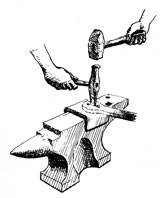
(Bealer)
Tools for Self Reliance: Practical Help to Practical People Overseas -- "In the struggle to develop, bare hands are not enough -- Could you work without tools?" This British charity supports workers in some of the world's poorest countries by providing basic hand-tools and promoting local tool-making. TFSR refurbishes second-hand hand tools and sewing machines collected from British homes and sends them to community groups in Africa. It also supports the makers of tools -- Africa's blacksmiths. With tools sent from Britain they have already made well over a million items, now in daily use in their communities. The blacksmiths provide tools to artisans, including farmers, many of whom are women, and offer an accessible, cheap source of repair work. It also supports blacksmith training programs in Tanzania, Zimbabwe and Sierra Leone.
http://www.tfsr.org/
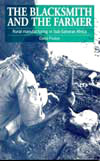 "The Blacksmith and the Farmer -- Rural Manufacturing in Sub-Saharan Africa" by David Poston, 1994, Practical Action, ISBN 1853391271
"The Blacksmith and the Farmer -- Rural Manufacturing in Sub-Saharan Africa" by David Poston, 1994, Practical Action, ISBN 1853391271
Poston's recognition of the significance of traditional blacksmithing to rural economies came during a study visit to Zaire and Zambia in 1986. "The Manie blacksmiths' cry for tools with which to work resulted in five weeks spent making tools with them in 1987. The very positive results of this second visit and the realization that the blacksmiths are able to develop themselves and their colleagues led to a third visit in 1988, at the blacksmiths' request." This led to a job invitation from the Intermediate Technology Development Group and further projects in Malawi, Zimbabwe and Tanzania. This book is the result, along with experiences of ITDG program workers. Buy from Amazon.com: The Blacksmith and the Farmer
"The Survival of the Fitter: Lives of some African engineers" by John Powell, 1995, Practical Action, ISBN 1853393169
Traces the development of Ghana's informal engineering sector through the progress of the actual people involved. The first generation of grassroots engineers are wayside vehicle mechanics, or "fitters", engaged in repairing machinery. Powell shows how the fitter's evolution to a manufacturer of tools, machines and equipment serving a wide range of "secondary" urban and rural industries, is central to progress in engineering, and that engineering and engineers are central to the development of an economy. Buy from Amazon.com: The Survival of the Fitter
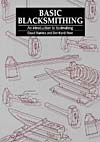 "Basic Blacksmithing -- An Introduction to Toolmaking With Locally Available Materials" by David Harries and Bernhard Heer, 1993, Stylus, ISBN 1853391956
"Basic Blacksmithing -- An Introduction to Toolmaking With Locally Available Materials" by David Harries and Bernhard Heer, 1993, Stylus, ISBN 1853391956
Learn to make or repair tools and many other metal products. Basic and advanced rural blacksmithing techniques and step-by-step instructions on how to make a range of tools and useful items from scrap metal. Builds on traditional techniques and describes how to set up your own workshop with bellows, hearth, and anvil. Hundreds of diagrams. Buy from Amazon.com: Basic Blacksmithing
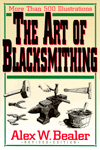 "The Art of Blacksmithing" by Alex W. Bealer, 1969, Revised edition 1995, Castle Books, ISBN 0-7858-0395-5
"The Art of Blacksmithing" by Alex W. Bealer, 1969, Revised edition 1995, Castle Books, ISBN 0-7858-0395-5
Bealer is credited with single-handedly bringing the ancient art of blacksmithing back from the edge of extinction in the Western world. His book sparked a revival of interest and now, 30 years later, blacksmithing is a thriving craft with thousands of practitioners. The book takes a close-up look at blacksmithing through the ages, showing how blacksmiths worked, what they made and how they made it. How to set up a shop, build a forge, detailed drawings and plans -- over 500 illustrations. Buy from Amazon.com: The Art of Blacksmithing
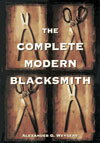 "The Complete Modern Blacksmith" by Alexander G. Weygers, 1997, Ten Speed Press, ISBN 0898158966
"The Complete Modern Blacksmith" by Alexander G. Weygers, 1997, Ten Speed Press, ISBN 0898158966
Compilation of three previous books, The Making of Tools, The Modern Blacksmith, and The Recycling, Use and Repair of Tools. Sculptor-artist-blacksmith Weygers wrote these books 30 years ago as notes to his lectures and courses on blacksmithing and they've been in constant demand ever since. Part of the course was making a set of tools which were worth more than the course cost! Weygers wouldn't buy anything he could make, and emphasizes recycling and scrounging raw material. Well illustrated, full of wit, wisdom and cunning technique. Buy from Amazon.com: The Complete Modern Blacksmith
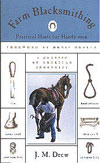 "Farm Blacksmithing: Practical Hints for Handy-Men" by James M. Drew, Denis Boyles, 2000, The Lyons Press, ISBN 1585740977
"Farm Blacksmithing: Practical Hints for Handy-Men" by James M. Drew, Denis Boyles, 2000, The Lyons Press, ISBN 1585740977
Time-honored instruction on all the essential skills of farm blacksmithing. Complete, no-nonsense guide first published a hundred years ago, covers both history and craft. Begins with the basics: how to set up a blacksmith shop, use of essential tools, selecting materials; goes on to a complete education in the most essential techniques. Step-by-step course in forging a wide variety of useful items from cutlery, candlesticks, and lanterns to horseshoes and handy farm devices. Illustrations throughout. Part of The Lyons Press series of authentic Americana from the turn of the century. Buy from Amazon.com: Farm Blacksmithing
Complete book free online at Cornell University's Core Historical Literature of Agriculture Library:
http://chla.mannlib.cornell.edu/cgi/t/text/text-idx?c=chla;idno=2734502
 "Blacksmithing" by James M. Drew, 1935, Webb Book Publishing Company
"Blacksmithing" by James M. Drew, 1935, Webb Book Publishing Company
Drew was former Instructor in Blacksmithing at the School of Agriculture, University of Minnesota. General blacksmithing, with the focus on the farm shop. Well illustrated with line drawings. Complete book free online at Cornell University's Core Historical Literature of Agriculture Library:
http://chla.mannlib.cornell.edu/cgi-bin/chla/chla-idx?notisid=ABN5768
"New Edge of the Anvil -- A Resource Book for the Blacksmith" by Jack Andrews, 1977, revised edition 1994, SkipJack, ISBN 1879535092
Comprehensive guide for the beginner or a reference for the advanced metalworker, covers tools, equipment, processes, with photographs of the work of historical and contemporary master smiths, with tables and charts, clearly written explanations. Thorough coverage of all aspects of blacksmithing. This book is currently used as a text at many schools and workshops. Buy from Amazon.com: New Edge of the Anvil
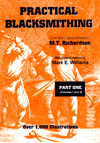 "Practical Blacksmithing Vol I, Vol II" by M.T. Richardson, 1899, reprint 1998
"Practical Blacksmithing Vol I, Vol II" by M.T. Richardson, 1899, reprint 1998
A basic resource for today's blacksmith. Volume I begins with an account of the tools and equipment of the blacksmith, shop plans, diagrams demonstrating various smithing techniques, iron and steel, basic processes such as drilling, fullering, and swaging. Volume II covers various processes such as welding, brazing, soldering, forging, cutting, bending, setting, and tempering. Download the complete book free from the CD3WD online 3rd World library (51.7Mb pdf):
http://www.fastonline.org/CD3WD_40/JF/412/04-114.pdf
Buy the book from Amazon.com: Practical Blacksmithing
ABANA -- the Artist Blacksmiths' Association of North America publishes two quarterly member magazines, The Anvil's Ring and The Hammer's Blow, with in-depth arts and blacksmithing articles, tutorials, critiques. Gallery of works of famous historical blacksmiths and ABANA members. Mailing list, list of plans, searchable supplier directory database with more than 1,000 suppliers.
http://www.abana.org/
TheForge email mailing list is maintained by ABANA, the Artist-Blacksmith's Association of North America. Subscribe online:
http://www.abana.org/
Or email: listproc@wugate.wustl.edu
Type: subscribe theforge <your name>
The Elektric Anvil has a set of searchable web forums, real-time Java-based chat room, extensive links page, site search and more. The Blacksmith's Compendium, a collection of mailing list postings gleaned primarily from ABANA's TheForge mailing list organized into single documents for each of a range of topics -- a good FAQ.
http://www.celticknot.com/elektric/anvil/index.html
Blacksmiths Virtual Junkyard -- "The idea here in Blacksmiths Virtual Junkyard is to carry on the blacksmith tradition of sharing ideas, sources and information with fellow blacksmiths." The JunkYard is an online blacksmiths' forum, with archive, the Sketchbook is for posting drawings, plans and information, Scrapbin for buy and sell listings -- anvils, forges, blacksmithing tools and equipment for sale, BigDogCatalog -- Frequently discussed subjects FAQ from the JunkYard forum: forges, anvils, power hammers, coal/fuel, iron/steel, flux, books, tools, safety, heat treating, bladesmithing, history. A good resource. Blacksmiths WorldWide is a directory of blacksmiths in dozens of countries ("Get in touch with smiths in Sri Lanka").
http://www.keenjunk.com/
"anvilfire" online blacksmithing and metalworkers reference has a lot of resources. FAQs and a Guru to answer questions, "Blacksmithing in the 21st Century -- An odd mix of FAQs and Articles", planned as a book but now an online reference, a Master's Plan File -- plans, drawings and ideas from the Guru's sketchbook, video demonstrations, bookshelf, links, news, conference reports, and articles.
http://www.anvilfire.com/
The monthly Blacksmith's Journal features blacksmithing techniques, tools, and forged ironwork. Index of monthly designs plus Sample page showing the step-by-step, fully illustrated projects of technique and design in every issue. Large collection of high-quality original designs, with Editor/Publisher Jerry Hoffmann's clear drawings. Nine annual volumes, order by volume or by issue. Loose leaf format for easy shop use and collection of issues.
http://www.blacksmithsjournal.com/
Anvil Magazine, Voice of the Farrier and Blacksmith -- monthly magazine with articles about horseshoeing and blacksmithing. Useful collection of online articles, interviews and how-to's, back issues, resources and links, site search.
http://www.anvilmag.com/
Lytton Creek Blacksmiths -- "Simple Texas hill country blacksmiths living in the past with a T-3 netfeed." FAQs and how-to's: Basics section covers basic terminology and overview plus instructions for making a pump bellows and simple forge. Advanced section has techniques on traditional welding, cutting and splitting and more. Links, resources, books, photos.
http://www.lyttoncreek.com/
"Blacksmithing: A Manual for Use in School and Shop" by Robert Washington Selvidge and James Miller Allton, 1925, Selvidge series of instruction manuals, Manual Arts Press
Selvidge was Professor of Industrial Education, and Allton, Instructor in Forging at the University of Missouri. Full analysis of the blacksmith's trade, with instructions and line illustrations. CoMplete book free online at Cornell University's Core Historical Literature of Agriculture Library:
http://chla.mannlib.cornell.edu/cgi/t/text/text-idx?c=chla;idno=2863914
Small iron foundry
Cupolas are vertical, air-blown coke-fired cylindrical furnaces for remelting iron or bronze. They're easy to build: basically a steel cylinder lined with fire clay and provided with an air supply.
Stewart Marshall of Marshall Machine Works Ltd. builds small cupolas. He says a 10-inch bore furnace costs less than US$200 to build and the blast can be provided by a large shop vac. One man can easily operate it alone. It will provide 20 to 25 lbs. of molten iron every 5 minutes and will burn for up to two hours.
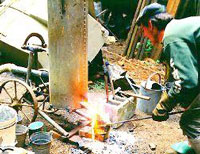 "Building Small Cupola Furnaces" by Stewart Marshall is a 100-page book with over 50 drawings and sketches showing how anyone can build a foundry for casting iron and bronze. Exact specifications for building very small cupolas, the whole subject of small ironfounding, is covered in thorough detail, with chapters and tips on moulding, sand preparation, refractories, building all the equipment from scratch. Also Home Foundry CD with more information. From Marshall Machine Works:
"Building Small Cupola Furnaces" by Stewart Marshall is a 100-page book with over 50 drawings and sketches showing how anyone can build a foundry for casting iron and bronze. Exact specifications for building very small cupolas, the whole subject of small ironfounding, is covered in thorough detail, with chapters and tips on moulding, sand preparation, refractories, building all the equipment from scratch. Also Home Foundry CD with more information. From Marshall Machine Works:
http://www.rockisland.com/~marshall/cupola.html
"The Cupola Furnace" by Edward Kirk, 1910, reprint by Lindsay Publications -- The iron caster's bible. The finest historical book on cupolas. Nearly 500 pages, covers all aspects of cupola construction and operation at the turn of the century, copiously illustrated. Buy from Amazon.com: The Cupola Furnace
"US Navy Foundry Manual", 1958 -- This heavily illustrated how-to manual covers everything from moulding and pouring to shaking out. Buy from Amazon.com: Foundry Manual
"How to Build a Forge" by David Wimberley
How to convert a standard water heater shell and old vacuum cleaner into a quality blacksmithing forge for very little money. This is a 20" diameter firebrick-lined design which requires no welding and has a hood that with careful installation will allow you to operate the forge indoors. Excellent plans. Buy from Amazon.com: How to build a forge
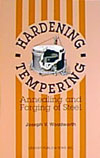 "Hardening, Tempering, Annealing and Forging of Steel" by Joseph V. Woodworth, 1907, reprint 1990 -- Valuable information on making, hardening and finishing all types of tools, including drills, mills, reamers, dies, countersinks, etc. Chapters include steel selection and identification, annealing processes, heating and cooling of steel, hardening, forging and welding, grinding, and more. Buy from Amazon.com: Hardening, Tempering, Annealing and Forging of Steel
"Hardening, Tempering, Annealing and Forging of Steel" by Joseph V. Woodworth, 1907, reprint 1990 -- Valuable information on making, hardening and finishing all types of tools, including drills, mills, reamers, dies, countersinks, etc. Chapters include steel selection and identification, annealing processes, heating and cooling of steel, hardening, forging and welding, grinding, and more. Buy from Amazon.com: Hardening, Tempering, Annealing and Forging of Steel
Machining
"Build Your Own Metalworking Shop from Scrap" by Dave Gingery -- seven books: charcoal foundry, lathe, shaper, drill press, milling machine, deluxe accessories and brake. Buy from Amazon.com: Build Your Own Metalworking Shop from Scrap: Series Set

Dave Gingery's metal lathe from scrap -- 7" capacity metal cutting lathe accurate to 0.001", 12" between centres. Uses castings produced by Gingery's charcoal foundry.
"Hasluck's Metalworking Handbook" by Paul N. Hasluck, 1907, reprint Lindsay Publications -- This master how-to manual covers all aspects of working metal -- 760 pages and 2,206 illustrations covering just about everything to do with metal. A lot of it just isn't taught anymore. "Foundry" covers building a Faraday blast furnace, a gas injector furnace, a brick-built furnace, an oil furnace, crucibles, flasks, sands and more. Contents: foundry work, smiths' work, surfacing metals, polishing metals: the machines and processes, annealing, hardening, and tempering, drilling and boring, taps, screwplates, and dies, soldering, brazing and riveting, forging iron and steel, working sheet metal, repousse work, oriental decorative brasswork, finishing, lacquering, and coloring brass, lathes and lathework, spinning metals on the lathe, tools for measuring and testing metalwork, building a 4 1/2 in. centre lathe, gilding and silver working, making a skeleton clock, building a small horizontal steam engine, making a 1/4-hp vertical steam engine, boiler making, building a petrol motor, making water motors, building a dynamo and electric motor, electroplating, wire working, electric bell making, making a microscope and telescope. From Lindsay Publications: http://www.lindsaybks.com/bks/hasluck/index.html
"Advanced Machine Work" by Robert H. Smith, reprinted by Lindsay Publications -- General machine shop book first publisshed in 1915, updated in 1925 -- new enough to still be of great value, but old enough to cover many techniques that are no longer taught. Easy-to-read text, step-by-step instructions, good illustrations, very wide-ranging, detailed instructions on all aspects of machine-shop work, including making many things that are only mass-produced today. 800 pages, heavily illustrated, amazing detail. Buy from Amazon.com: Advanced Machine Work
Appropriate technology
Appropriate technology resources
- Agriculture resources
- Wood resources
Blacksmithing
Wood fires that fit
Houses that fit
Water-powered water pumps
Journey to Forever and AT
- Chinese watering cans
- Handmade Projects watering can plans
- Hoe for victory!
- Billhooks and sickles
A better rat trap
- Rats and owls
- Chinese rat trap
- How to make a Chinese rat trap
- Bucket rat trap
Appropriate technology subjects